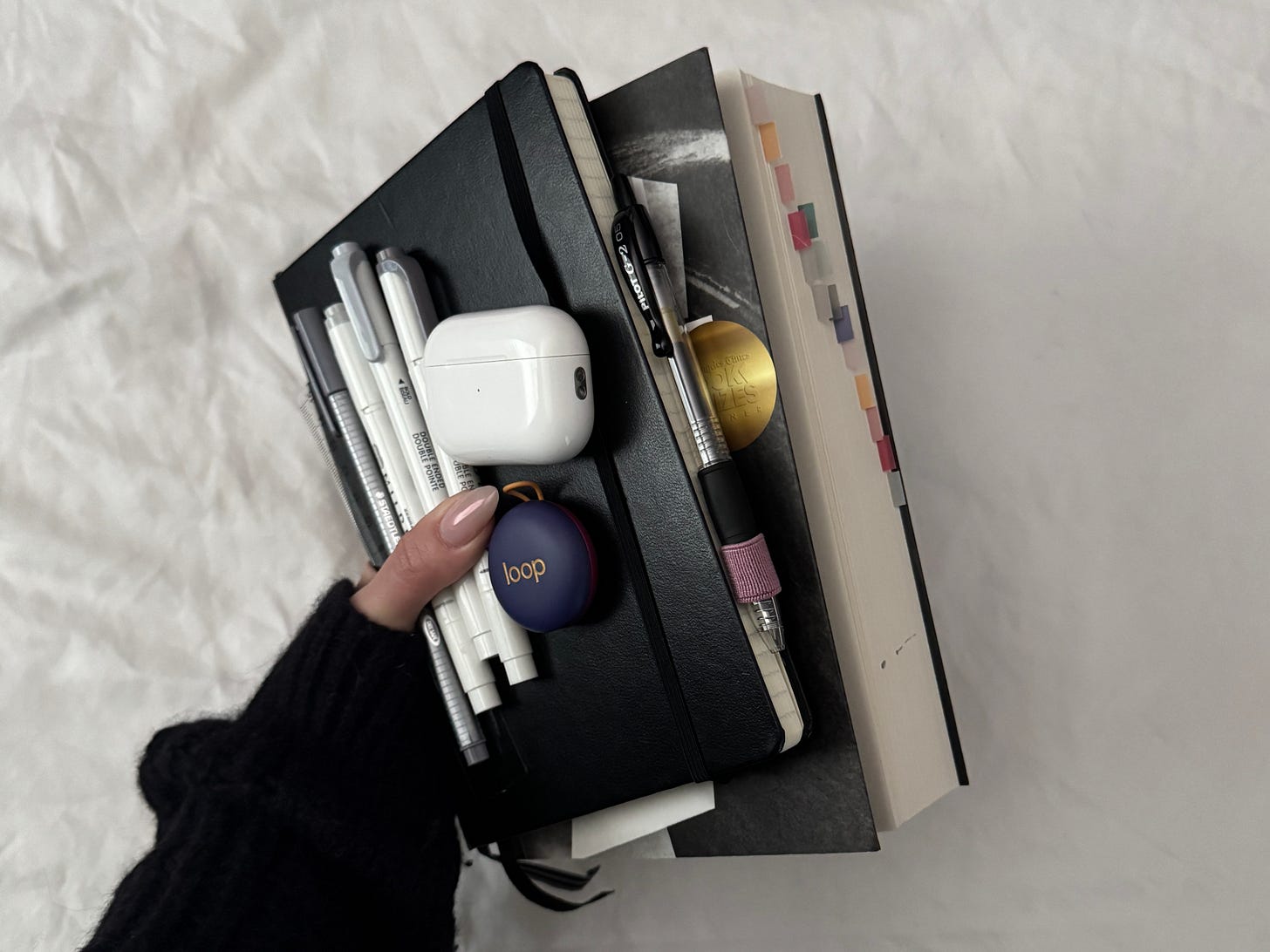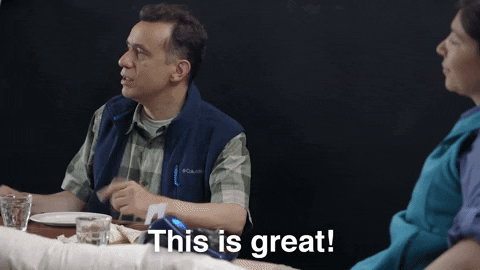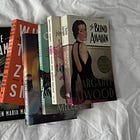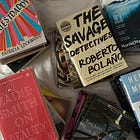How to read an intimidating book
book supplies, side quests, and the will to finish [Solenoid]
This is going to sound incredibly cheesy, but let me for a second. Ever since that momentous year 2020 when I read Glennon Doyle’s book Untamed, in moments of uncertainly or fear I repeat to myself
I can do hard things
Yes, I know it’s silly and heavy on the cringe, but it works for me. When
and I decided to buddy-read Solenoid, I knew that in order to do this hard thing, I would need more than the mantra, I would need a plan. What follows is how I approach reading an intimidating book.1. get some supplies and break it down
Non-negotiable book supplies for tackling any book, but especially the ones that require tuning out the noise
Sticky book tabs (I have only been able to find these on Amazon sry)
Quality non-bleed highlighters & pens (I like these highlighters and these pens for annotating, this pen for journaling)
A mini ruler (per
make sure to get a low-pro plastic one)Commonplace book or any notebook (I like this one with a pen loop)
Bonus: earplugs or noise-canceling headphones (I would be in jail for homicide if it weren’t for my AirPods and these earplugs)
Now that I have the supplies, the first step is to break the chonky book down into manageable bits. I scan the book for natural breaking points (chapters, sections) and determine how many pages I can reasonably get through per day, factoring in working a day job on most of them. For Solenoid, I thought about 40 pages would be reasonable based on a scientific matrix of density, font type, and reading timeline1. I use the sticky tabs to mark off each section so that I never have to remember when I’ve completed my assignment while also being so ✨pretty✨.
2. engage in some research and side quests
Once I’ve got the reading schedule, it’s time for a Google side quest. Usually, I prefer to waddle into a book with just vibes - there is nothing worse than spoiling an important plot point. But we aren’t talking about an Agatha Christie novel here - most likely, a bit of context will only deepen the reading experience and hopefully make it more enjoyable.
The simplest place to start is Wikipedia for juicy author deets. Mircea Cartarescu is a Romanian author and a full professor of literary studies at the University of Bucharest. His first book was poetry, and he was heavily influenced by 1960s American counterculture. He’s written things like “Love Poems,” Melancholy, and Beautiful Strangers. His award nomination list is longer than his work. His work is shaped by communism (and its fall) and experiences with censorship2. Are we in for some dark times, my friend??
Formal reviews are next. As a newer book, there isn’t a ton of online Solenoid content yet, but what I was able to find was helpful. In reviews, I am looking to go deeper into themes and background.
From the Mundane to the Divinely Gross, Anything Goes in This Novel (NYT)
“Oscillating between mundanity and metaphysical terror, the bleak, foundering edifice of Communist-era Bucharest trembles with possibility. This braiding of realism, hallucination, myth, and dream creates the distinctive pleasures and unruly challenges of Cartarescu’s baroque fictions.”
so we have
→ Communist-era Bucharest
→ baroque fictions
And then I’m down the rabbit hole of what it would have been like for Cartarescu to live through Communist-era Bucharest, the austerity policy, extreme rationing, and sometimes violent public discontent3. Baroque fiction “refers to a style of writing characterized by ornate language, complex sentence structures, and a rich tapestry of imagery4. A list of Goodreads Historical Fiction Baroque Books is a book list I’ve never once considered reading and probably never will5.
I also like to find comps that might give me an idea of what I’m in for. The NYT article likens Solenoid to Borges or Kafka. I’ve heard comparisons to Ed Park’s Same Bed, Different Dreams, Jon Fosse’s Septology, Witold Gombrowicz, and Olga Tokarczuk. I can now prepare myself for some absurd situations, some high/low contrasts, and an exploration of who is allowed access to culture. When reading, I will be looking for these themes and using my new background knowledge as contextual clues.
3. get to reading and annotating
There is no shortage of beautiful annotating methods proliferating on the internet. One I’ve absorbed is the highlighter-themes method, where you assign each major theme a highlighter color, creating a guide at the front of the book. The method supposedly deepens your reading experience and makes for easy reference.
However, this is where things got off the rails a bit for me starting Solenoid. I read the first two chapters ahead of schedule, partially because my curiosity got the better of me and partially to set myself up with some themes to focus on/research. NICE TRY PRECIOUS.
My mistakes were twofold - selecting three highlighters for aesthetic reasons that were basically the same damn color which made it so confusing to try and pair with themes; attempting to highlight by theme at all. Like honestly, this method just does not work for me. It takes too much brain power that should be directed toward understanding actual words. It’s also difficult when the themes start overlapping, which they did almost immediately. It’s fun for some close reading of shorter passages, but the idea of close reading an entire novel is upsetting to me.
My advice: if you want to attempt the thematic highlighter method, pick widely different colors and very distinct themes and do not limit yourself - you may need a grip of colors to match all the notable themes, and you may have rainbow-colored sections by the end.
4. journal or it didn't happen
Writing my thoughts as I read in a notebook is not new for me, although I previously suffered from Perfect Journal Syndrome. The Substack community has since helped me work through those feelings with advice on creating a commonplace book, which somehow eases the inner perfectionist - perhaps because the end goal is chaos. Although I will need a lot more supplies to make mine look anything like this6
The commonplace notebook is where I record thoughts as I am reading, unfiltered and as they come. With Solenoid, I also annotate the text as I go, so the notebook serves as a place to gather all the ideas together. My tactic is to read through a whole chapter/section and then go back to my annotations and write more fleshed-out ideas in the notebook. This prevents me from coming out of the text too much since any mental flow interruptions threaten me from ever getting through this 600+ page surreal novel. I always note the page of important quotes/passages for easy reference. I now keep a list of favorite quotes thanks to
too. Everything goes in! The commonplace book never judges.//
And… that’s it. That is how I tackle a fat chonky boy. This is the first time I have documented my process, and I surely have not perfected it, but learning as I go is part of the fun. If you have any of your own tips, please share!
Got any more tips for reading intimidating books?
Have you read or are you interested in reading Solenoid, or are you just going to let Martha and I tell you about it first?
What is the most challenging book you’ve ever read and why was it Ulysses?
This newsletter contains affiliate links. If you purchase using one of the links above, I will earn a baby-sized commission at no cost to you. Comment, share, repost, upgrade to paid, or buy me a coffee to support my work. Follow me @subversereads on Instagram for pretty book pictures. Your support (monetary or not) is why I keep going, so thank you.
See you around the bookshelf!
or that we have a two-week window in order to make it into our April reads 🤓
everything from Wikipedia, Mircea Cartarescu
spoiler, it wasn’t good.
Baroque fiction Google search results
not including The Crimson Petal and the White by Michael Faber, which I inexplicably attempted to read unsuccessfully in my 20s.
don’t trip already have some washit tape and I’ve got tabs and corner bookmarks in my shopping cart I can’t resist suppliessssss


















Solenoid!! I'm feeling huge admiration (some jealousy!?) that you're tackling this one (it's on my list). Can't wait to hear your take– and Martha's! Cărtărescu visited my grad program's campus last fall, and while I didn't manage to attend the event, I did hear of an amusing moment where Cărtărescu was really going on about how popular his work is with the women in Romania, how much women love his incredible writing, etc., only for Sean Cotter to come in and break it to him that in the English, Solenoid is really has a bit of a "lit bro" following
I'm so so intrigued by Solenoid! Keen to know how you feel about it. The most difficult book I read so far has been Proust's In Search of Lost Time, moreso out of sheer length than anything.